
At this year’s Scottish Smallholder Festival I attended a fascinating talk by Jack Flusk and Katie Swift of Conservation Pigs about their pioneering use of pigs for woodland conservation work. With benefits to the pigs, the pig keeper and the woodland this is a practice which could become far more widespread.
All the photos in this blog are of pigs owned by Conservation Pigs and their work.
How can pigs benefit woodland?
Pigs roaming in woodland can, under the right circumstances, recreate the effect the Wild Boar once had on our native forests. They can improve the biodiversity of woodland where a few species have come to dominate or they can help eradicate invasive species. Most importantly they can do this without the environmentally damaging effects of heavy machinery and chemicals.

The beneficial effects of pigs in woodland can include:
- acting as a natural predator for invasive species
- reducing the density of the ground layer
- thinning out saplings
- increasing the percentage of dead-wood in the woodland
- breaking up soil promoting regeneration
- providing invertebrate habitat through their dung
- generating nesting materials for birds
When pigs are given access to a woodland they will clear the ground layer, removing plants such as nettles, brambles, bracken, willow and couch grass. They will eat all tree saplings which are small enough, reducing the number of non-native or unwanted tree species. They can also be used to clear fallen seeds such as acorns which can be toxic to horses and cattle. Where a specific invasive species has become problematic they can assist in its removal:
Bracken: Managing bracken with pigs is an ongoing project rather than a once off; they will need to be run on the land several years in a row as the bracken regenerates. Pigs will remove Bracken rhizomes and break up the years of thick bracken matting on the woodland floor. Pigs are uniquely suited to bracken management, as they are resistant to the various toxins and carcinogens present in the rhizomes, unlike other livestock. They will happily eat bracken and its rhizomes, although they do need supplementary feeding alongside this.
Rhododendron: Pigs cannot be used to completely clear rhododendron, but they are used to help in a number of ways. Firstly they can be sent in before clearance to break up the ground layer allowing easier access. They will also then dig up large bushes that can then be easily removed. After clearance pigs can be used to break up the leaf litter and encourage regeneration of other species, and to suppress regrowth of the rhododendron.

Other invasive species: Conservation Pigs are investigating whether pigs can be effectively used to control extremely problematic invasive species such as Himalayan Balsam and Japanese knotweed. If so, there is huge potential in using pigs to control these plants in an eco-friendly way.
Serious science underpins the work of conservation pigs: Katie is an ecologist and the project began as a research project for her masters degree. On every site Katie conducts surveys, before and after the pigs go to work, as well as weekly monitoring of the impact of the pigs impacts while they are onsite.

About the pigs
Conservation pigs has experimented with several different breeds of pigs before settling on saddlebacks. Some breeds dig too far and do too much damage (as Jack points out; pigs dig as far as their nose, and saddleback have a short nose!) while others have been found to spend rather too much of their time asleep and have limited impact. The pigs are kept in 3 herds and move from site to site with in a radius of 30 miles, keeping the need for paperwork to a minimum.
Jack and Katie also use pigs differently at different ages; the older pigs are often sent in first for the heavy clearance; removing the really coarse material, while the young pigs are sent in later to till the soil and generate a good seed bed. They carefully monitor the impact the pigs are having and can move their feeding location in order to encourage the pigs to work in a new location.

From the pig’s point of view the arrangement is ideal. Pigs allowed to roam in woodland have a varied natural diet and are able to express their natural behaviour. This sort of environment is pig heaven!

What are the pitfalls?
As can be seen from photos, the impact of the pigs on the woodland can be dramatic and, as Katie points out, putting pigs on a piece of land without careful planning and clear objectives is likely to result in nothing more than ‘a big, muddy, smelly, hole’. Before using pigs for conservation work you need to be clear what you want to remove, what you want to preserve and what you want to encourage. You need to think of the implications for the time of year you release the pigs on site, how long you give them to work and how you are going to monitor the impact. Sometimes pigs need to be onsite in autum, to clear seeds and saplings and break up leaf litter, then off again by spring to allow regeneration. In other cases, however, the pigs need to be onsite in spring as they are needed to remove the new growth of an invasive species.

One of the major challenges Conservation pigs ran into at first was getting pigs on and off site. In some cases they have had to halter train pigs and walk them on. The secret to this turned out to be observing the dynamic within the group and figuring out which pig the others would follow. Getting the pigs off site can also be an issue, sometimes they are having way too much fun! The key to this problem is also understanding herd dynamics, and using experienced sows. Getting pigs off site is one of the reasons the boars are kept at the farm now.

The other major challenge (and the biggest expense) of the work is fences. Large areas need to be fenced, sometimes part of an area needs to be fenced temporarily. The nature of woodlands is that trees and branches will at times damage fences and the nature of pigs is that they will escape if they possibly can! On one site a group of young pigs would visit the local pub on an almost daily basis. No one ever worked out how they were escaping. Conservation Pigs use a range of fencing solutions, Jack has found ClipX to be the most sustainable.

More about Conservation Pigs
Jack Flusk and Katie Swift established Conservation Pigs LTD in 2012, bringing together their two passions; conservation and pigs! Their website states:
“At Conservation Pigs we have two aims:
1. To support and enhance the conservation and management of landscapes for the benefit of flora and fauna, through the use of pigs.
2.To actively support the conservation of British rare breed pigs through the use of pedigree registered pigs for all management activities.”
In addition to their conservation work, in which they work with local authorities and a wildlife trust, they sell pig arks through Foragers Arks and pig meat through Cook and Foragers. Conservation pigs also prove a free educational service schools, colleges, community groups, charities and wildlife organisations.
I was impressed by the pioneering work of conservation pigs. Particularly their careful observation of the pigs, the natural behaviour and herd dynamics, and their rigorous data collection and monitoring which underpins their work.

The views expressed in our blog are those of the author and not necessarily lowimpact.org's
3 Comments
-
1Ian Hamilton November 3rd, 2017
Do recall some good few years ago now, that a TV person did what these folk are doing, on a piece of land he had in the North Midlands. His name escapes me but his pork products (sorry!!!) were well received due to their unique wild flavour. He observed that pigs in bracken was devastating to the bracken that was running out of control.He even had before and after photos of areas where his animals had been. Very impressive. Didn`t know that they also were partial to Himalayan Balsom. Its a problem here but its on public land next to a river with a major thorough fare not too far away. Still, good going folks. More strength to your elbows, an` all that.
-
2Macarena Mata July 7th, 2023
Hi, we've got around 1/2 of an acre of garden at our home in Hertfordshire, and it's run over by brambles. Do you know how we could kind of 'hire' some pigs to clear the land? Any ideas greatly appreciated!
-
3Diana Mason July 11th, 2023
Hi. I love pigs and I think that they could be used much more for land clearance and conservation.
my question is, can the meat be used from pigs who have eaten Bracken rhizomes ? Can it go into the food chain?
thanks




 How the study of animal behaviour (ethology) can help you keep livestock more ethically and sustainably
How the study of animal behaviour (ethology) can help you keep livestock more ethically and sustainably
 What’s the best thing to do with the uplands, in terms of sustainability?
What’s the best thing to do with the uplands, in terms of sustainability?
 Does the sustainability of meat production depend on the size of a holding and the number of animals kept on it?
Does the sustainability of meat production depend on the size of a holding and the number of animals kept on it?
 Grazing: why simulating wild herds maximises benefits for farmers, livestock and ecology
Grazing: why simulating wild herds maximises benefits for farmers, livestock and ecology
 Is it ethical to eat meat, or to keep animals for meat or dairy?
Is it ethical to eat meat, or to keep animals for meat or dairy?
 On a small scale, why is it illegal to give food waste to chickens and other animals?
On a small scale, why is it illegal to give food waste to chickens and other animals?
 The case for feeding food waste to pigs
The case for feeding food waste to pigs
 Permaculture pigs: integrating pigs into a permaculture design
Permaculture pigs: integrating pigs into a permaculture design
 Living and working as a horse logger in Scotland
Living and working as a horse logger in Scotland
 How invasive non-native species threaten our woods and what we can do to help
How invasive non-native species threaten our woods and what we can do to help
 Rewilding or local food production?
Rewilding or local food production?
 Keeping livestock
Keeping livestock
 Pigs
Pigs
 Tree / woodland management
Tree / woodland management


